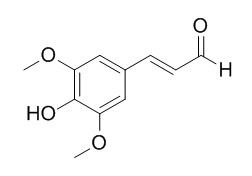Sinapaldehyde
Sinapaldehyde has effects against 65 strains of Candida,Sinapaldehyde inhibits prostaglandin synthetase in a dose-dependent way, it dose-dependently inhibits ethyl phenylpropiolate-induced edema of the rat ear, and can inhibit electrically induced contractions of the guinea pig ileum in a dose-dependent way.The reaction of sinapaldehyde and methylpyranoanthocyanin can obtain a new bluish pigment.
Inquire / Order:
manager@chemfaces.com
Technical Inquiries:
service@chemfaces.com
Tel:
+86-27-84237783
Fax:
+86-27-84254680
Address:
1 Building, No. 83, CheCheng Rd., Wuhan Economic and Technological Development Zone, Wuhan, Hubei 430056, PRC
Providing storage is as stated on the product vial and the vial is kept tightly sealed, the product can be stored for up to
24 months(2-8C).
Wherever possible, you should prepare and use solutions on the same day. However, if you need to make up stock solutions in advance, we recommend that you store the solution as aliquots in tightly sealed vials at -20C. Generally, these will be useable for up to two weeks. Before use, and prior to opening the vial we recommend that you allow your product to equilibrate to room temperature for at least 1 hour.
Need more advice on solubility, usage and handling? Please email to: service@chemfaces.com
The packaging of the product may have turned upside down during transportation, resulting in the natural compounds adhering to the neck or cap of the vial. take the vial out of its packaging and gently shake to let the compounds fall to the bottom of the vial. for liquid products, centrifuge at 200-500 RPM to gather the liquid at the bottom of the vial. try to avoid loss or contamination during handling.
Phytomedicine.2022, 100:154085.
Oncol Lett.2020, 20(4):122.
Food and Chemical Toxicology2020, 111221
Free Radic Biol Med.2016, 97:307-319
Plants (Basel).2023, 12(1):163.
Cell Chem Biol.2019, 26(1):27-34
Microchemical Journal2024: 196:109676.
Tokyo Pharmaceutical University2020, 500001431953.
Pharmacol Rep.2019, 71(2):289-298
Evid Based Complement Alternat Med.2016, 2016:4357656
Related and Featured Products
J Med Microbiol. 2013 Feb;62(Pt 2):232-40.
Influences of cinnamic aldehydes on H⁺ extrusion activity and ultrastructure of Candida.[Pubmed:
22034160 ]
METHODS AND RESULTS:
The antifungal effects of cinnamaldehyde, 4-hydroxy-3-methoxycinnamaldehyde (coniferyl aldehyde) and 3,5-dimethoxy-4-hydroxycinnamaldehyde (Sinapaldehyde) were investigated against 65 strains of Candida (six standard, 39 fluconazole-sensitive and 20 fluconazole-resistant). MICs of cinnamaldehyde, coniferyl aldehyde and Sinapaldehyde ranged from 100 to 500 µg ml(-1), 100 to 300 µg ml(-1) and 100 to 200 µg ml(-1), respectively. All tested isolates showed a marked sensitivity towards these aldehydes in spot and time-kill assays. Sinapaldehyde was found to be the most effective, followed by coniferyl aldehyde and cinnamaldehyde. At their respective MIC(90) values, the three compounds caused mean inhibition levels of glucose-stimulated H(+)-efflux of 36, 34 and 41 % (cinnamaldehyde), 41, 42 and 47 % (coniferyl aldehyde) and 43, 45 and 51 % (Sinapaldehyde) for standard-sensitive, clinical-sensitive and clinical-resistant isolates, respectively. Inhibition levels of H(+)-efflux caused by plasma membrane ATPase inhibitors N,N'-dicyclohexylcarbodiimide (100 µM) and diethylstilbestrol (10 µM) were 34, 45 and 44 %, and 57, 39 and 35 %, for standard-sensitive, clinical-sensitive and clinical-resistant isolates, respectively. Intracellular pH (pHi) was found to decrease by 0.34, 0.42 and 0.50 units following incubation with three tested aldehydes from the control pHi of 6.70. Scanning electron microscopy and transmission electron microscopy analysis was performed on a representative strain, C. albicans 10261, showing alterations in morphology, cell wall, plasma membrane damage and lysis. Haemolytic activity of the three compounds varied from 10 to 15 % at their highest MIC compared to an activity level of 20 % shown by fluconazole at 30 µg ml(-1).
CONCLUSIONS:
In conclusion, this study shows significant activity of cinnamic aldehydes against Candida, including azole-resistant strains, suggesting that these molecules can be developed as antifungals.
Planta Med. 1992 Feb;58(1):14-8.
Pharmacologically active phenylpropanoids from Senra incana.[Pubmed:
1620737 ]
Coniferaldehyde, scopoletin, Sinapaldehyde, and syringaldehyde were isolated from an aqueous extract of Senra incana.
METHODS AND RESULTS:
All four compounds inhibited prostaglandin synthetase in a dose-dependent way. Compared to aspirin, the potency of coniferaldehyde and scopoletin was about five times higher, whereas syringaldehyde and Sinapaldehyde had about half the potency of this reference compound. On topical application, Sinapaldehyde and scopoletin dose-dependently inhibited ethyl phenylpropiolate-induced edema of the rat ear. The active dose range was 1-10 micrograms/ear. Higher doses had a lower effect.
CONCLUSIONS:
Syringaldehyde was active in the range 20-100 micrograms/ear, whereas the effect of coniferaldehyde was inconclusive.
Coniferaldehyde and Sinapaldehyde inhibited electrically induced contractions of the guinea pig ileum in a dose-dependent way. Syringaldehyde showed a weak inhibition at a concentration of 550 microM.
Tetrahedron Letters, 2011, 52(16):1996-2000.
Synthesis of a new bluish pigment from the reaction of a methylpyranoanthocyanin with sinapaldehyde[Reference:
WebLink]
METHODS AND RESULTS:
The synthesis of a new pigment with a bluish color was obtained from the reaction of methylpyranomalvidin-3-glucoside with Sinapaldehyde and its formation mechanism seems to involve a charge-transfer reaction pathway. The structure of this compound was fully characterized by LC/DAD-MS and NMR. Its equilibrium forms present in water at different pH values and the respective ionization constants were determined by UV–visible spectroscopy.
CONCLUSIONS:
The results revealed the presence of three equilibria involving only deprotonation reactions at the 7-OH and 4′-OH positions of the pyranoanthocyanin moiety and at the 4′″-OH of the syringol moiety (p K a1 = 3.64 ± 0.01; p K a2 = 8.02 ± 0.01; p K a3 = 11.19 ± 0.01).



